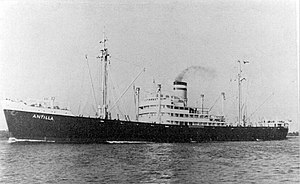SS Antilla (1939)

SS Antilla in 1939
|
|
| History | |
|---|---|
| Nazi Germany | |
| Name: | ES Antilla |
| Namesake: | Antilla, Cuba |
| Owner: | Hamburg America Line |
| Operator: | Hamburg America Line |
| Port of registry: |
|
| Builder: | Deutsche Werft, Hamburg |
| Yard number: | 222 |
| Launched: | 21 March 1939 |
| Completed: | 11 July 1939 |
| Maiden voyage: | 15 July 1939 |
| Out of service: | 10 May 1940 |
| Identification: | |
| Fate: | scuttled |
| Status: | wreck |
| General characteristics | |
| Type: | cargo ship |
| Tonnage: | |
| Length: | 398.3 ft (121.4 m) |
| Beam: | 55.7 ft (17.0 m) |
| Depth: | 22.8 ft (6.9 m) |
| Propulsion: |
|
| Speed: | 15 knots (28 km/h) |
| Crew: | 35 |
| Sensors and processing systems: |
|
| Notes: | |
SS Antilla (or "ES Antilla", with "ES" standing for "Elektroschiff" German: electric ship) was a Hamburg America Line (HAPAG) cargo ship that was launched in 1939 and scuttled in 1940.
Antilla was built for trade between Germany and the Caribbean, and was named accordingly. Antilla is a city in Holguín Province in eastern Cuba.
Antilla was launched in Hamburg on 21 March 1939 and completed on 11 July. She was one of three sister ships launched in 1939 for HAPAG. She and her sister Orizaba were built by Deutsche Werft in Finkenwerder, Hamburg, while their sister Arauca was built by Bremer Vulkan in Bremen-Vegesack.
Antilla and her sisters had turbo-electric transmission. Each ship had two oil-fired high-pressure boilers that fed a single AEG turbo generator. This produced current for an AEG electric propulsion motor that drove a single propeller shaft.
On 15 July 1939 Antilla left Hamburg on her maiden voyage, which took her to the Caribbean. The voyage was hampered by technical problems with her propulsion system, but she eventually reached Curaçao in the Netherlands Antilles.
On 9 August Antilla left Curaçao for Galveston, Texas, where she loaded 3,000 tons of sulphur for Europe. On 25 August, while still in Galveston, she received a radio message from Germany that included the code word "Essberger", which was a signal for her captain, Captain Ferdinand Schmidt, to open sealed orders. The sealed orders had been issued to all German merchant ships, and directed them to leave main shipping lanes. Shortly afterwards Antilla received a second radio message with the same code word. According to the sealed orders this was an order for captains to alter their ships' names and appearance, communicate only in code and return to Germany as soon as possible.
...
Wikipedia
